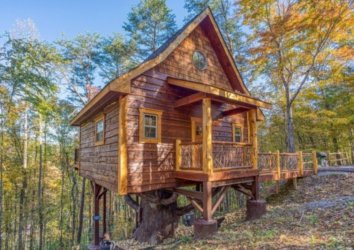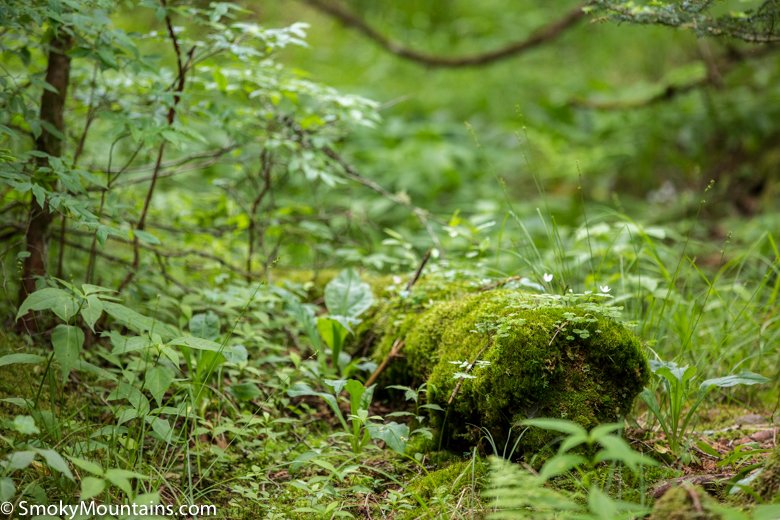While there’s plenty to dazzle down in the basins, valleys, and coves of the Great Smoky Mountains, it’s hard to resist the siren call of the high country. You can get a taste of the heights of one of the loftiest ranges in the Appalachians from the road, of course. That includes the drive up to the summit of the highest peak of all, the 6,643-foot Clingmans Dome.
But to really, truly enter the heart of the Smoky Mountain high country, we advise hitting the trail. Many of the finest hikes in Great Smoky Mountains National Park—a hiker’s wonderland with more than 800 miles of trail—trace remote ridgelines and hop between vista-rich vantages. Revel in the wide-open views of mountaintop balds with their breezy grasses and flowering thickets. Watch the mists roll in from an outcrop of the Anakeesta Formation. Wander in delicious silence through the mysterious spruce-fir forests that darken the highest land in the park.
The Appalachian Trail running through the interior of Great Smoky Mountains National Park along the Smoky Mountain divide is the most famous way to tromp these highlands. That said, several day hikes—including ones that partly follow the Trail—provide a more accessible introduction.
What follows are four top-notch hiking routes on high in the Great Smokies:
Snake Den Ridge Trail

Photo Credit by @campinglulu on Instagram
Head up to the backcountry crest of the eastern Great Smokies on the demanding, but super-rewarding, Snake Den Ridge Trail. This 5.3-mile-long route climbs from Cosby Campground southwestward to meet the Appalachian Trail very close to Inadu Knob, an important peak rising better than 5,900 feet. Crossing Rock, Inadu, and Crying creeks along the way, this rigorous path tunnels through rhododendron slicks on its way into the high spruce-fir timber and ridgetop glades.
Less than a mile from its Appalachian Trail terminus, the Snake Den Ridge Trail meets the Maddron Bald Trail coming from the northwest. Heading a short way down that trail to check out Maddron Bald itself treats you to that natural shrub garden’s awesome views, including of Inadu Knob.
And when you hit the Snake Den Ridge-Appalachian Trail junction, hiking southwestward on the Trail will take you not only to Inadu Knob itself but also—past Yellow Creek and Deer Creek gaps—the 6,370-foot summit of Old Black. This is among the highest peaks in the Great Smokies.
Ambitious trekkers can also continue onward on the Appalachian Trail, southwest of Old Black to tread the slopes of several other of the range’s crowning peaks, including 6,621-foot Mount Guyot and 6,417-foot Mount Chapman.
Sugarland Mountain Trail

Photo Credit by @jdeane4 on Instagram
The 12.1-mile-long Sugarland Mountain Trail is one of Great Smoky Mountains National Park’s preeminent ridge walks—and usually a great option for finding some solitude. The path traces the spine of mighty Sugarland Mountain in the center of the park. This is a long, narrow divide running from the central crest of the Smokies northwestward between the Little River and West Prong of the Pigeon drainages. Whether you arrange a shuttle or tackle some out-and-back portion of the trail, you’ll be treated to plenty of highland ambiance and far sightlines.
Those views include lofty Great Smoky peaks such as 6,188-foot Mount Collins, 5,802-foot Mount Mingus, and 6,593-foot Mount LeConte, not to mention the distinctively craggy Chimney Tops that protrude from a spur off Sugarland Mountain. You’ll dip through a variety of vegetation communities on this traverse, from cove hardwood headwaters to dry pine-oak stands and shady spruce-fir groves.
Rocky Top

Almost 14 miles round-trip and involving close to 4,000 feet of elevation gain, the hike up to Rocky Top is one of the toughest on this list. But fit hikers committing a full day to get to this vantage—one of several summits on the knobby ridgeline of 5,527-foot Thunderhead Mountain—will be rewarded for some of the finest views in the Great Smokies.
You can reach Rocky Top from a few routes, actually, but the most direct is via the Lead Cove and Bote Mountain trails up to the Appalachian Trail Bote Mountain, in this case, will be your leadup ramp to the main Smoky Mountain divide. Livestock was once driven along this former track to reach the grassy grazing grounds of Spence Field. Thickening some with shrubbery—including mountain laurels that put on a dazzling early-summer show—Spence Field remains a beautiful bald with its own great prospects.
But continue eastward up to the 5,447-foot Rocky Top, and you’ll find yourself swimming in panoramic splendor. The views run down the crest of the Great Smokies to Clingmans Dome, take in huge Mount LeConte and plunge thousands of feet down to Cades Cove to the north and Fontana Lake to the south.
The Boulevard to Mount LeConte

Photo Credit by @kempstone on Instagram
A number of outstanding trails lead up to the great massif of Mount LeConte, the third-highest peak in the Great Smoky Mountains and likely the mountain in the East with the most topographic relief. The longest, though, and the most sustained high-country walk, is the Boulevard Trail. This remote path approaches the summit from the southeast via the long ridge called (you guessed it) the Boulevard, which connects Mount LeConte with the Smoky Mountain divide at Mount Kephart.
The Boulevard Trail itself is 5.4 miles long, but to get to its southern terminus, you need to hike in along the Appalachian Trail from Newfound Gap. Returning to the trailhead via the Boulevard after “bagging” Mount LeConte involves more than 16 miles. You can shorten the trek a little (and avoid covering the same ground twice) by taking the Boulevard up to Mount LeConte, then descending via the Alum Cake Trail: a 13.1-mile one-way hike.
Detours off the Boulevard route take you to some awesome spots. You can tack on visits to the stunning vantages of Charles Bunion and the Jump-off, and also take a quick jaunt up to Myrtle Point, a subpeak of LeConte famed for its sunrise views.
Get the Ridgetop Vibes in Great Smoky Mountains National Park
For those willing to put in the miles and sweat the switchbacks, the high country of the Great Smokies offers staggering views and some precious quiet in the nation’s busiest national park.




